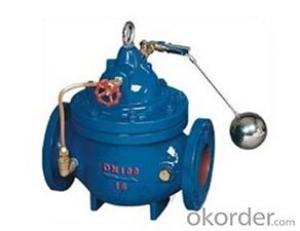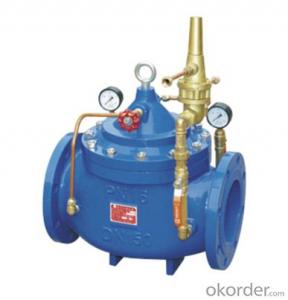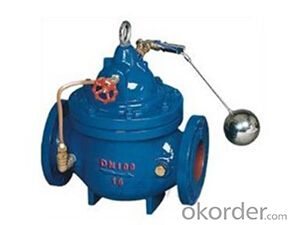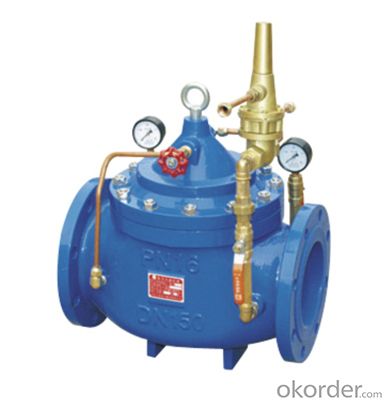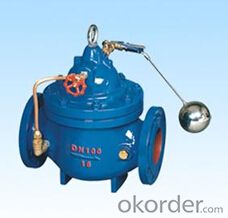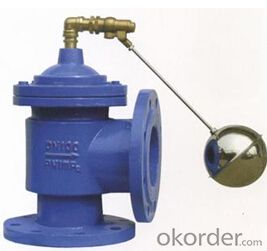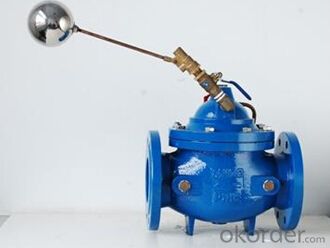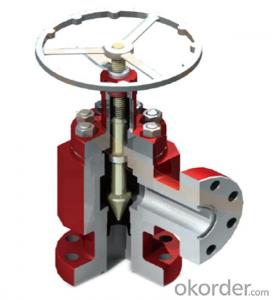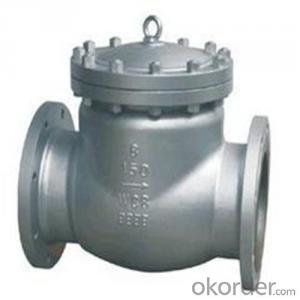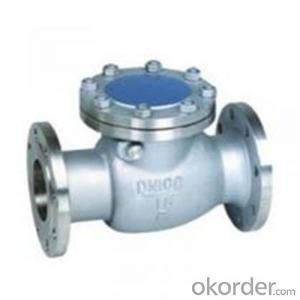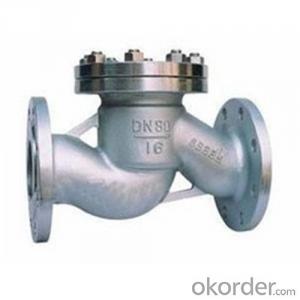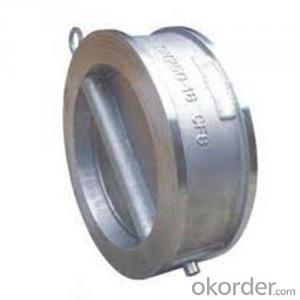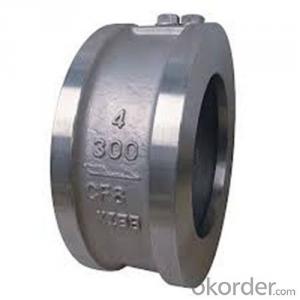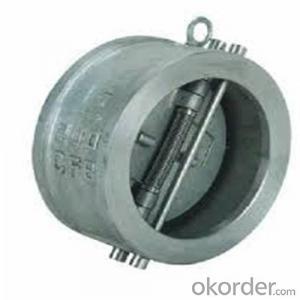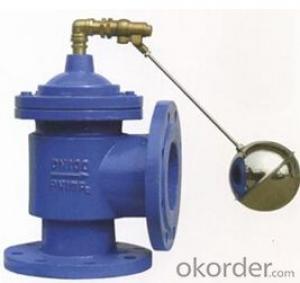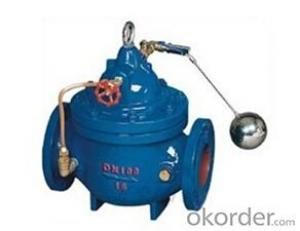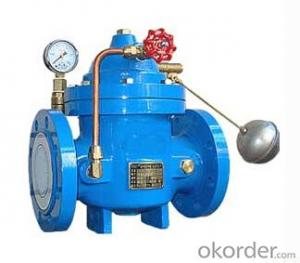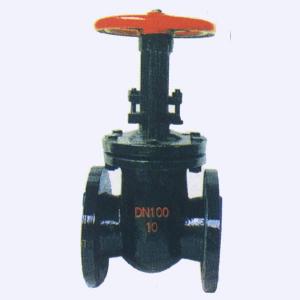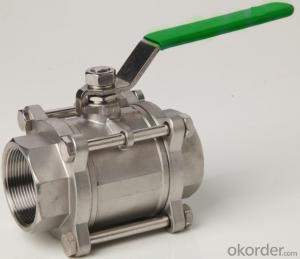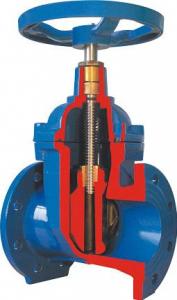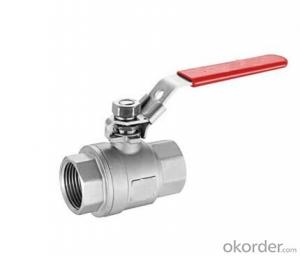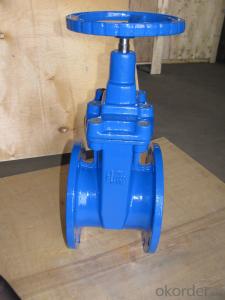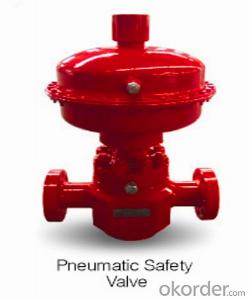DN600 Ductile Iron Remote control float valve
- Loading Port:
- Tianjin
- Payment Terms:
- TT OR LC
- Min Order Qty:
- 1 set
- Supply Capability:
- 5000 set/month
OKorder Service Pledge
OKorder Financial Service
You Might Also Like


General valve using the market long-term, widespread Water Leakage, rust phenomenon, soft sealing gate valve produced by the introduction of foreign advanced technology of the enterprise. To overcome the poor sealing gate valve, general elastic fatigue, rust and other defects. Soft sealing gate valve is a traditional valve replacement products, the compensation effect of using flexible gate produce small deformation, achieve good sealing effect, the valve has a light switch, reliable sealing, good elastic memory and long service life and other significant advantages, can be widely used in water, sewage, construction, food, medicine, metallurgy, electric power, textile, energy systems, fluid pipeline regulation and closure devices as.
The characteristics of:
- flat style seat
The traditional control valve often pass after washing due to foreign objects such as stone, wood, cement, paper, and other debris deposited on the valve at the end of the groove. Close but not close easily lead to the formation of Water Leakage phenomenon, the lower part of the soft sealing gate valve with water using the same flat design, easy to siltation caused by debris, the fluid unimpeded.
And the overall package glue
The valve plate is made of high-quality rubber overall, the outsourcing of plastic, making the domestic first-class rubber vulcanization vulcanization after the valve plate to ensure accurate geometry, and the rubber and ductile iron gate is connected firmly, not easy to fall off and good elastic memory.
And corrosion resistance
The valve body adopts epoxy coating powder, can prevent the corrosion and rust, and can be used for sewage systems.
And not easy to break
Traditional cast iron garden gate often hit foreign objects, collision or overlap caused by the fracture phenomenon. Because the valve to switch to ductile iron, this is the case already significantly reduced.
Three "O" ring seal
As the valve stem with three "0" ring ring seal design, can reduce friction when the switch is greatly reduced, Water Leakage phenomenon and can cut off the water supply construction not replace sealing ring.
And help to drink
Due to the internal body to non-toxic epoxy resin coating, gate of the inner and outer surfaces are completely coated with rubber and can not rust or corrosion of water available to drink.
- Casting valve
Valve body casting, precise geometry makes the body without any internal finishing to ensure that the valve seal.
And light weight
The valve is made of ductile cast, lighter in weight than conventional gate weight about 20%-30%. Convenient installation and repair.
Overview:
General valve using the market long-term, widespread Water Leakage, rust phenomenon, soft sealing gate valve produced by the introduction of foreign advanced technology of the enterprise. To overcome the poor sealing gate valve, general elastic fatigue, rust and other defects. Soft sealing gate valve is a traditional valve replacement products, the compensation effect of using flexible gate produce small deformation, achieve good sealing effect, the valve has a light switch, reliable sealing, good elastic memory and long service life and other significant advantages, can be widely used in water, sewage, construction, food, medicine, metallurgy, electric power, textile, energy systems, fluid pipeline regulation and closure devices as.
The characteristics of:
- flat style seat
The traditional control valve often pass after washing due to foreign objects such as stone, wood, cement, paper, and other debris deposited on the valve at the end of the groove. Close but not close easily lead to the formation of Water Leakage phenomenon, the lower part of the soft sealing gate valve with water using the same flat design, easy to siltation caused by debris, the fluid unimpeded.
And the overall package glue
The valve plate is made of high-quality rubber overall, the outsourcing of plastic, making the domestic first-class rubber vulcanization vulcanization after the valve plate to ensure accurate geometry, and the rubber and ductile iron gate is connected firmly, not easy to fall off and good elastic memory.
And corrosion resistance
The valve body adopts epoxy coating powder, can prevent the corrosion and rust, and can be used for sewage systems.
And not easy to break
Traditional cast iron garden gate often hit foreign objects, collision or overlap caused by the fracture phenomenon. Because the valve to switch to ductile iron, this is the case already significantly reduced.
Three "O" ring seal
As the valve stem with three "0" ring ring seal design, can reduce friction when the switch is greatly reduced, Water Leakage phenomenon and can cut off the water supply construction not replace sealing ring.
And help to drink
Due to the internal body to non-toxic epoxy resin coating, gate of the inner and outer surfaces are completely coated with rubber and can not rust or corrosion of water available to drink.
- Casting valve
Valve body casting, precise geometry makes the body without any internal finishing to ensure that the valve seal.
And light weight
The valve is made of ductile cast, lighter in weight than conventional gate weight about 20%-30%. Convenient installation and repair.


- Q: Steam is a gaming network and valve is a company, but what else? I think that it might be nothing; they both suck at working.
- I don't understand this question fully, but I think you like my answer: Steam is a software for gaming articles, but it also meaning gas on another word. Valve (www.google.rs/search?q=Valvehl=srclient=firefox-ahs=SCurls=org.mozilla:en-US:officialprmd=imvnssource=lnmstbm=ischei=8zHfTr2iIsKnhAeTy-yVBQsa=Xoi=mode_linkct=modecd=2ved=0CCgQ_AUoAQbiw=800bih=393) is a legal company, same as meaning the link I put there. Hope it helps! :)
- Q: Hey I'm high rite now and i have a checkup for mitro-valve prolapse tomrow, i was wondering if they will take my blood and see THC in me....
- Get as high as you can and stay up all night partying!!!
- Q: my dad is going to go under heart valve replacement what are the chances of him surviving he is 58 years old and has copd
- It depends a lot on which valve and why it's being replaced, but unless the COPD is very bad, the average chance that a 58yo man who does not have any other major medical problems will survive single-valve replacement surgery is better than 98% if the surgery is done by an experienced surgeon at a good hospital. The COPD will very likely mean that his post-operative recovery will be prolonged and difficult, but he should do fine.
- Q: Exactly what is an EGR valve where is it located?
- It does not help warm the engine. It is shut off at idle, and opens as some others have said when cruising. If it opens at idle, it will cause the engine to run rough.
- Q: why can't i just use solenoid valves hooked to a small bank of relays(using relay logic to control operation) connected to thermostats to control a multi zone boiler system? it would work, but can i do it, why must i use expensive zone valves?
- Its just an educated guess but I would say it would cause system shock if a valve just snapped shut as against closing gently. Assuming the system was shutting down as a zone valve shuts the control switch opens and turns off the plant whilst the valve is still partly open. With a solenoid unless you fit a timer to pre shut off the plant then shut off the solenoid you would probably cause some plant damage. Also by the time you have wired all that lot up you may as well do the job with a zone valve.
- Q: i know its going to drop some oil, im just wondering to what extent? how much oil is going to spill out?
- The answer Briggs gave is pretty much on the target except I believe he missed your primary question: will oil run out of the valve cover and get onto other engine parts. The answer to this is most likely but there are some precautions you can take to minimize the oil. Assuming the engine is fairly clean inside, the oil galleys should allow most of the oil in the upper head/valve spring area to drain back into the engine. If the engine has set and not been run for several hours (over night?) the majority of the oil will have drained out of the head area. There will be pockets of oil trapped in the upper head area but that most likely will not run out when the cover is removed. First thoroughly clean the valve cover(s) so no dirt is present to fall into the open head area. Get some absorbant towels (paper or cloth) and pack around the head below the valve cover gasket line to catch and absorb any oil that might ooze from under the valve cover when it is unbolted and removed. After getting the valve cover off, make sure the absorbant material is still in place and if necessary, you can absorb the pooled oil pockets still in the upper head area to prevent seepage from these area. Good luck.
- Q: I've just been told that I need to replace the valve cover gasket on my 97 Volvo 850.....to the tune of $650.00 .....ouch.....is it that difficult to fix?......can you use the red gasket sealant? is there a difference between the head gasket and the valve cover gasket.......yeah I know there probably is.......but when I look on line all i can find is head gaskets......no valve cover gaskets........which scares me into thinking they are the same thing.....i'm hopeing i'm wrong......if its the valve cover gasket it looks like it would be right on top of the engine and fairly accessable.......or am I wrong......sure would like to save the $650 if it is something i can do myself!!!!
- Valve Cover Gasket is a tuff thing to fix alone. I would say, take it to the shop and pay the $650.00- look at it like this, at least you will have a garentee if anything goes wrong you take that bad boy back and have them hook it up the right way! Best of Luck!
- Q: Can someone please explain the difference between a pressure tap valve and a gate valve (if any).
- Pressure tap valves are usually globe valves which have a disc with a rubber seal on it that turns down on a threaded shaft which as it turns closes off the flow of the water as it gets close to its seat bottom. Some pressure tap valves can also be ball valves which have a ball in them that has a hole in it. as the ball is turned the process fluid is controlled by how much of the hole in the ball is exposed to the line. A gate valve has a gate in it or I like to imagine it as a wall in a secret passage. As it is turned down the 'gate' slides down a grooved path to close off the process flow. like a secret door. They all are used to control the flow of a process. Which kind of valve used is determined by what kind of process you are controlling, the temperature and pressure are considered as well as what kind of control one needs.
- Q: I've been diagnosed with mitral valve prolapse, my doctor just told me that i need to setup an appointment with the hospital to look at treatments for heart mitral valve prolapse-to possibly have a heart valve replaced. I am wondering if i should setup an appointment with mayo clinice in minnesota to get another opinion on that? I'm wondering if surgery is an only option available to me, i have been taking beta blockers that have been no help for the past 3-4 months. Thanks.
- hi Sporad I had a mitral valve replacement 4 years ago and I'm alive. Ive been taking beta blockers for 6 years and they work a bit there is one blue tablet that works very well at slowing down hart rates but Dr's don't want to prescribe it till your on your on the way to the knife. When you come out of the op they will be giving you pannadol every 4 hours so be prepared to take lot's of them as no other pain killer performs the job. Start coughing in post op and don't stop you have to cough your lungs back up onto your rib cage. Get out of bed and exercise you lungs the post op hart ward is not the place to get better. Once you have your new valve or your old ones been fixed up you are ready to go. The stitches don't come out your blood flow has been restored its back to being great. The bad days are really bad at the start and then they get less bad unless you have a really bad day. Just remember they don't just give these things to people who don't need them. If you need one your getting a new chance to live. The team of people who put new Mitral Valves in are not just standing around waiting for handouts they are do it once fix it up people. They wont be doing it again for a long time. It costs heaps of money so relax ha ha and make sure your not taking any blood thinning meds just before your op even rub on cream and eye drops check it all with your Doctor. Because they can cause big problems in the surgery. Ask for a baked carbon valve and join me in the carbonvalvers group. I had mine done at the Royal Melbourne,however the MAYO clinic is not a back street job so book in quick. I know you want to time to relax and think things over and there will be plenty of time for that when your walking up and down the wards. ohno not the white tube. All the best Alan
- Q: what is meant by inherent characteristic for the steam control valve??
- There are different type of valves, (ball, gate, globe, needle, diaphram) each have their own characteristics in how they operate and the effect they have on flow. Inherent characteristic would be an effect that valve has on the fluid flowing through it.(steam can also be considered a fluid ) An example is a globe valve used to throttle a flow does so by adjusting the size of its opening. In essense its a variable orifice. Flow through an orifice results in a pressure drop across that orifice. So, an inherent characteristic of a globe valve is a pressure drop.
Send your message to us
DN600 Ductile Iron Remote control float valve
- Loading Port:
- Tianjin
- Payment Terms:
- TT OR LC
- Min Order Qty:
- 1 set
- Supply Capability:
- 5000 set/month
OKorder Service Pledge
OKorder Financial Service
Similar products
Hot products
Hot Searches
Related keywords
